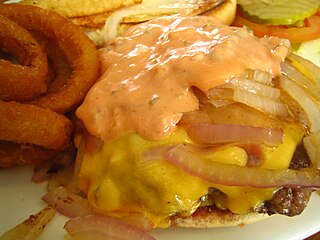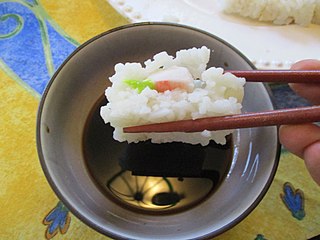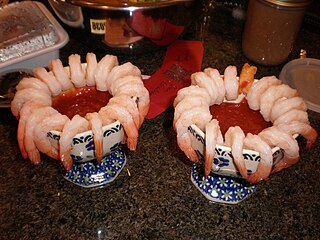
Mayonnaise, colloquially referred to as "mayo", is a thick, cold, and creamy sauce commonly used on sandwiches, hamburgers, composed salads, and French fries. It also forms the base for various other sauces, such as tartar sauce, fry sauce, remoulade, salsa golf, ranch dressing, and rouille.

Ketchup or catsup is a table condiment with a sweet and sour flavor. The unmodified term ("ketchup") now typically refers to tomato ketchup, although early recipes for various different varieties of ketchup contained mushrooms, oysters, mussels, egg whites, grapes or walnuts, among other ingredients.

Russian dressing is a piquant American salad dressing consisting of mayonnaise, ketchup, and other ingredients.

Arctic Circle Restaurants is an American chain of burger and shake restaurants based in Midavle, Utah, United States.

Rémoulade is a cold sauce. Although similar to tartar sauce, it is often more yellowish, sometimes flavored with curry, and often contains chopped pickles or piccalilli. It can also contain horseradish, paprika, anchovies, capers and a host of other items.

A dip or dip sauce is a common condiment for many types of food. Dips are used to add flavor or texture to a food, such as pita bread, dumplings, crackers, chopped raw vegetables, fruits, seafood, cubed pieces of meat and cheese, potato chips, tortilla chips, falafel, and sometimes even whole sandwiches in the case of jus. Unlike other sauces, instead of applying the sauce to the food, the food is typically placed or dipped into the sauce.

French dressing is a creamy dressing in American cuisine that varies in color from pale orange to bright red.

Cocktail sauce, also known as seafood sauce, is one of several types of cold or room temperature sauces often served as part of a dish referred to as a seafood cocktail or as a condiment with other seafoods. The sauce, and the dish for which it is named, are often credited to British celebrity chef Fanny Cradock, but seafood cocktails predate her 1967 recipe by some years.

The generic term for condiments in the Filipino cuisine is sawsawan. Unlike sauces in other Southeast Asian regions, most sawsawan are not prepared beforehand, but are assembled on the table according to the preferences of the diner.

Heinz Tomato Ketchup is a brand of ketchup manufactured by the H. J. Heinz Company, a division of the Kraft Heinz Company.

Salsa golf is a cold sauce of somewhat thick consistency, common in Argentina. It is made from mayonnaise with a smaller amount of tomato-based sauce such as ketchup, as well as seasonings including pimento, oregano, and cumin.

Marie Rose sauce is a British condiment often made from a blend of tomatoes, mayonnaise, Worcestershire sauce, lemon juice and black pepper. A simpler version can be made by merely mixing tomato ketchup with mayonnaise. The sauce was popularised in the 1960s by Fanny Cradock, a British cook.

Thousand Island dressing is an American salad dressing and condiment based on mayonnaise that can include olive oil, lemon juice, orange juice, paprika, Worcestershire sauce, mustard, vinegar, cream, chili sauce, tomato purée, and ketchup or Tabasco sauce. It also typically contains finely chopped ingredients, which can include pickles, onions, bell peppers, green olives, hard-boiled egg, parsley, pimento, chives, garlic, or chopped nuts.

Sir Kensington's is an American food company with headquarters in New York City, New York. It was founded by Mark Ramadan, Scott Norton, Brandon Child, and Win Bennett. The company produces Non-GMO Project Verified condiments including ketchup, mustard, mayonnaise, ranch dressing, and "Fabanaise", a vegan mayo whose name is a portmanteau of the substitute ingredient aquafaba and mayonnaise which it mimics.
















